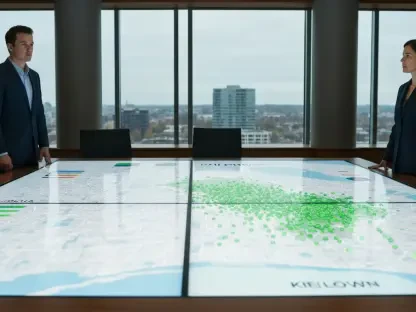Oman’s construction industry stands at a pivotal moment, emerging from a challenging phase into a period of renewed vigor and opportunity, with a significant turnaround projected at a 3.6% annual increase this year. After navigating a difficult stretch marked by a negative compound annual growth rate of -0.8% from 2020 to 2024, the sector is elevating its market value to OMR 3.81 billion. This resurgence isn’t merely a statistical rebound; it reflects a deeper transformation fueled by strategic national priorities and a commitment to economic diversification. As the industry looks ahead to a steady growth path with a 2.8% CAGR from 2025 to 2029, reaching OMR 4.40 billion by the end of the forecast period, stakeholders are keenly observing the forces shaping this evolution. From government-led infrastructure projects to a growing emphasis on sustainable practices, the dynamics at play are as diverse as they are impactful, setting the stage for a robust future.
Key Growth Drivers
Infrastructure and Urban Development
The backbone of Oman’s construction resurgence lies in substantial investments in infrastructure and urban development, which are redefining the nation’s landscape. Government-backed projects, particularly in transportation sectors such as highways, railways, and airports, are pivotal in enhancing connectivity across the sultanate. These initiatives are not just about building roads or terminals; they aim to position Oman as a regional logistics hub, facilitating trade and industrial growth. Complementing these efforts are urban development schemes that prioritize the expansion of cities to accommodate a growing population. With a clear focus on creating modern, accessible urban centers, these projects are driving demand for construction services, from foundational work to finishing touches, and are expected to sustain momentum through 2029 as national plans unfold with precision and ambition.
Beyond transportation, utility infrastructure projects are equally critical in supporting Oman’s broader economic goals. Investments in power, water, and sewer systems are addressing the needs of both burgeoning urban areas and industrial zones, ensuring that growth is sustainable and scalable. These developments are often tied to larger diversification strategies that seek to reduce reliance on traditional revenue streams. As cities expand and industrial activities diversify, the construction sector benefits from a steady pipeline of projects that require innovative engineering solutions and long-term planning. This dual focus on connectivity and essential services underscores how infrastructure is not just a driver but a foundation for the industry’s projected growth, offering opportunities for both local and international firms to contribute to Oman’s evolving skyline.
Economic Diversification Goals
Oman’s Vision 2040, a strategic roadmap for economic diversification, plays a central role in steering the construction sector toward sustained growth. This national initiative aims to reduce dependency on oil revenues by fostering development in non-oil sectors, with construction emerging as a key pillar. Large-scale projects funded through public and private partnerships are creating a ripple effect, stimulating demand for materials, labor, and expertise. By prioritizing sectors like tourism, logistics, and manufacturing, the government is channeling resources into building the necessary infrastructure and facilities, from resorts to industrial parks, which in turn fuel construction activity. This alignment with broader economic objectives ensures that the industry’s growth is not a fleeting surge but a calculated step toward long-term stability.
Moreover, the emphasis on diversification has attracted foreign investment, further amplifying construction opportunities. International stakeholders are increasingly drawn to Oman’s stable political environment and its strategic location as a gateway to global markets. This influx of capital is evident in mixed-use developments and commercial hubs that cater to a diversifying economy, particularly in major urban centers. The government’s proactive policies, including incentives for private sector involvement, are fostering an environment where construction firms can thrive while contributing to national goals. As these economic strategies continue to mature over the coming years, the construction sector stands to gain from a consistent flow of projects that align with a vision of a more resilient and varied economic landscape.
Emerging Trends in Construction
Sustainability and Green Building
A defining trend in Oman’s construction industry is the growing commitment to sustainability, with green building practices gaining traction across various sectors. This shift reflects a broader alignment with global environmental standards, as well as local policies that incentivize eco-friendly development. Residential, commercial, and institutional projects are increasingly incorporating energy-efficient designs and sustainable materials to reduce environmental impact. This isn’t merely a response to regulatory pressures; it’s a market-driven demand as clients and investors prioritize long-term cost savings and environmental responsibility. The focus on green construction is projected to intensify through 2029, positioning Oman as a leader in sustainable building within the region and attracting partnerships with international firms specializing in such technologies.
The adoption of green building initiatives, however, comes with its own set of challenges and opportunities. While the long-term benefits of reduced energy consumption and lower operational costs are clear, the upfront investment in sustainable materials and technologies can be significant. Addressing this requires innovative financing models and greater awareness among stakeholders about the value of green certifications. Additionally, the need for skilled labor trained in sustainable construction techniques is becoming apparent, prompting calls for enhanced training programs. Despite these hurdles, the trend toward sustainability is opening doors for collaboration with global experts and is likely to shape project planning and execution in the years ahead, embedding environmental consciousness into the core of Oman’s construction ethos.
Market Segmentation Insights
Delving into the specifics of Oman’s construction market reveals a nuanced landscape where growth is concentrated in distinct segments. Residential construction, particularly in affordable and mid-tier housing, is witnessing robust demand, especially in Tier-2 and Tier-3 cities where urbanization is accelerating. This contrasts with Tier-1 urban centers, which are hubs for luxury developments and high-end commercial spaces like Grade A offices and retail complexes. Infrastructure projects, spanning transportation and utilities, remain a dominant force, driven by government initiatives to enhance national connectivity and support industrial diversification. This segmentation across over 40 sub-categories highlights that opportunities are not one-size-fits-all but vary significantly by sector and location, requiring tailored approaches from industry players.
Further analysis of these segments uncovers additional layers of potential. In the commercial sector, hospitality and restaurant developments are gaining momentum, fueled by tourism goals under national diversification plans. Industrial construction, focusing on manufacturing facilities, aligns with efforts to bolster non-oil economic activities, while institutional projects like healthcare and educational facilities address growing societal needs. Each segment presents unique drivers and challenges, from funding availability to regulatory requirements, shaping how contractors and developers prioritize their investments. As the market evolves, understanding these granular differences becomes crucial for capitalizing on specific growth pockets, ensuring that strategies are aligned with the diverse demands of Oman’s construction landscape.
Operational Challenges and Opportunities
Cost Management Dynamics
Navigating the complex terrain of cost management remains a critical challenge for Oman’s construction industry, particularly in an era of fluctuating global commodity prices. A detailed breakdown of expenses reveals that material costs, including essentials like cement and steel, are heavily influenced by international supply chain dynamics, often leading to unpredictable budgeting scenarios. Labor costs, segmented by skilled and unskilled workers as well as specific trades like plumbing and electrical services, add another layer of complexity. Effective cost control demands not only real-time monitoring of these variables but also strategic partnerships with suppliers to mitigate price volatility. For stakeholders, mastering these cost drivers is essential to maintaining project profitability without compromising on quality or timelines.
Equally important is the need for transparency and precision in financial planning to address these cost challenges. Advanced cost estimation tools and data analytics are becoming indispensable for forecasting expenses across new construction, redevelopment, and maintenance projects. Additionally, fluctuations in labor availability necessitate investment in workforce development to ensure a steady supply of qualified personnel, which can help stabilize costs over time. While these operational hurdles pose risks, they also present opportunities for firms to differentiate themselves through efficiency and innovation. By adopting technology-driven solutions and fostering a culture of cost awareness, companies can turn potential setbacks into competitive advantages, ensuring they remain agile in a market where every rial counts.
Regional Growth Variations
Oman’s construction growth is far from uniform, with significant variations across different regions that demand localized strategies. Tier-1 cities, as major economic hubs, are at the forefront of high-end commercial and residential developments, attracting substantial investment for projects like luxury housing and premium office spaces. These urban centers benefit from established infrastructure and a concentration of business activity, making them focal points for large-scale construction. However, the intense competition and higher costs in these areas require firms to focus on quality and innovation to stand out. Understanding the unique dynamics of these cities is vital for stakeholders aiming to capitalize on the premium market segments that dominate urban growth patterns.
In contrast, Tier-2 and Tier-3 cities offer a different set of opportunities, often centered on affordable housing and smaller infrastructure projects. These regions are experiencing rapid urbanization, driven by population growth and government efforts to decentralize development. The demand for mid-tier residential units and essential infrastructure like local roads and utilities is creating fertile ground for construction activity, often with lower entry barriers compared to Tier-1 markets. Yet, challenges such as limited access to skilled labor and logistical constraints must be addressed to fully unlock this potential. Tailoring approaches to these regional disparities—balancing the high-stakes environment of major cities with the untapped promise of smaller locales—will be key to maximizing growth across Oman’s diverse construction landscape.
Reflecting on a Path Forward
Looking back, Oman’s construction industry demonstrated resilience as it navigated past economic headwinds to achieve a notable recovery, underscored by a 3.6% growth in market value to OMR 3.81 billion this year. The journey through earlier challenges honed a sector now poised for steady expansion, driven by targeted investments in infrastructure and a commitment to sustainability. Government initiatives and private sector engagement played crucial roles in reshaping the market, while detailed segmentation and regional analyses provided clarity on where opportunities flourished. As the industry reflects on these milestones, the focus shifts toward actionable strategies for the future. Stakeholders are encouraged to prioritize adaptive planning, leverage technology for cost efficiency, and foster collaborations to advance green building practices. Embracing region-specific approaches and investing in workforce skills will further ensure that growth remains inclusive and sustainable, paving the way for a construction sector that continues to support Oman’s broader economic vision.









